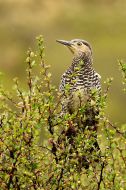Chilean Flicker
Pitío
Colaptes pitius
Length: 330mm. Sexes slightly unlike. Bill grey; iris yellowish green; forehead, crown and nape solid plumbeous grey; lores, orbital area, cheeks, chin and throat buffy cream; the malar region shows a broad very dark red stripe. Foreneck blackish, the upper portion with buffy cream margins forming a few bars, remainder with a few streaks in same colour; sides of neck blackish with whitish barring; hind neck blackish brown. Back and scapulars blackish brown with thin whitish barring; rump whitish, uppertail coverts blackish with alternating whitish barring; rectrices blackish, the two central feathers and outer feathers show a few pale greenish yellow bars. Breast and flanks buffy whitish with broad blackish barring; abdomen buffy whitish; undertail coverts blackish with alternating whitish barring. Wing coverts blackish brown with whitish barring; secondaries blackish brown with whitish barring, the rachis of feathers is greenish yellow; primaries blackish brown with pale greenish yellow spots on outer vexillum and feather rachis greenish yellow in colour; underwing coverts and axillaries yellowish cream. Legs grey.
The female is almost like the male but the malar region is dark grey. Juveniles are similar to adults but lack the malar line. Easily recognised by its medium size and coloration, this bird earns its name from its loud and repeated calls. Habits and behaviour: it is found in pairs or groups of up to five or six individuals. It inhabits fringes and open areas in forests, wooded open fields, scattered woods and thickets. Quite tame, mostly arboreal, although it often perches on the ground or on rocks. Common, it can be found in populated areas.
Its diet is composed of a wide variety of insects and their larvae, worms and small invertebrates. It forages both on tree trunks and boughs and on the ground. Although it taps on wood it is mostly beneath the bark that is searches for food.
It nests in holes bored into tree trunks, also at the bottom of burrows in earthy banks. Up to six white eggs are laid. Range: the race Colaptes pitius cachinans occurs from Neuquén to southern Santa Cruz all over the subantarctic forest and adjacent areas. This race is also found in the south of Chile from Chiloé to Magallanes. The nominate race is found in the north of Chile from Llanquihue to Atacama.
Illustrated Handbook of the Birds of Patagonia
Kindless: Kovacs Family |









